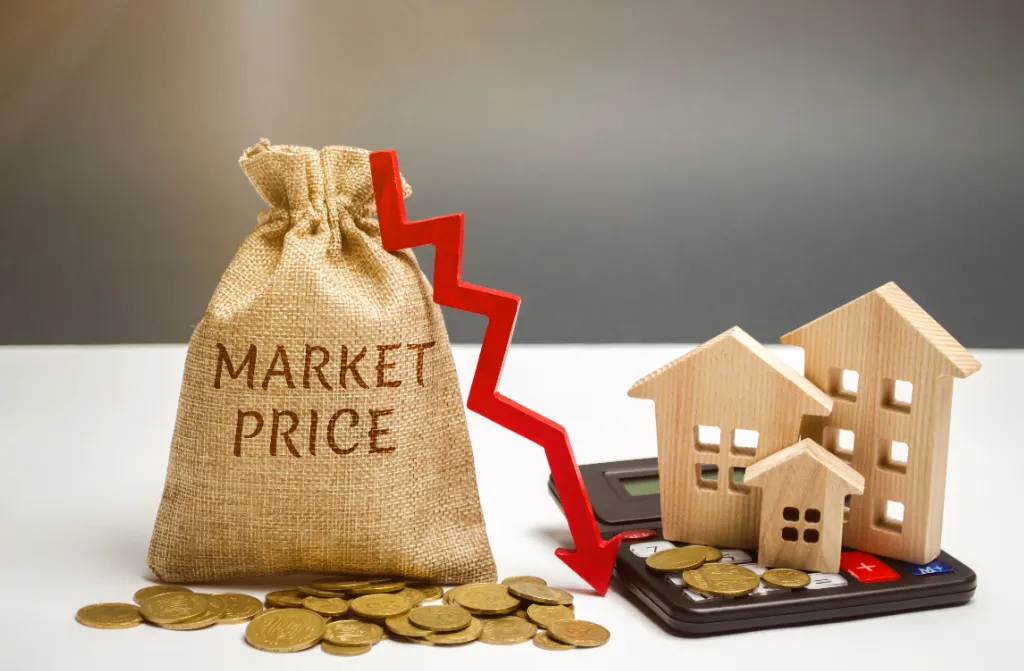The housing market is a dynamic sector that is pivotal in economies worldwide. It is subject to fluctuations and occasional downturns, known as housing market corrections. These natural and unavoidable cycles impact buyers and sellers. They reshape the real estate landscape and influence the broader financial system.
Housing market corrections occur when the demand for homes declines. Or when it becomes insufficient to sustain prevailing property prices. As a result, the market experiences a slowdown. It leads to price reductions and, at times, declining sales volumes. These corrections are essential to the market’s self-regulating mechanism. They help to balance supply and demand over the long term.
Understanding the underlying causes and consequences of housing market corrections is crucial. They can create challenges and uncertainties. But they also present opportunities for those well-prepared to navigate the changing tides. A correction may provide potential buyers a more cost-effective entry point into the property market. Sellers may need to adjust their strategies to adapt to shifting conditions.
Throughout history, the housing market has experienced various correction phases. Some were more severe than others. Learning from past occurrences can provide valuable insights into mitigating risks. They can also foster a sustainable real estate ecosystem. This article explores the intricacies of housing market corrections. It examines their causes, impacts, and strategies to manage such fluctuations successfully.
What is a housing market correction?

A housing market correction is a natural part of the economic cycle. This correction affects the real estate industry. After an extended period of solid expansion, it is marked by a decrease in real estate prices. It is important to note that, while being called a “correction,” it does not indicate a crash in the housing market. It’s neither a complete collapse of the real estate sector. Instead, it is a self-adjusting mechanism. It helps to bring housing prices back to more sustainable and realistic levels.
Depending on many factors, a housing market correction’s size, and length might change. It considers the magnitude of earlier price increases and the underlying economic circumstances. Corrections can be short-lived, spanning only a few months, or they may persist for a couple of years. Similarly, the extent of the price change may differ from one market to another. Some regions might experience a modest price decline. Others may witness more significant drops.
Causes of housing market corrections
Policymakers, investors, and homeowners must comprehend the reasons for housing market corrections. The following paragraphs will explore the primary factors contributing to housing market corrections. They are drawn from historical examples and economic principles.
1. Economic Cycles and Speculative Bubbles

The economy’s cyclical nature is one of the primary causes of corrections in the housing market. Over time, economies experience periods of growth and expansion, followed by contractions. During a boom phase, speculative bubbles may form in the housing market. They are driven by irrational exuberance and easy credit availability. These bubbles lead to inflated housing prices. They are detached from fundamental factors such as demand, supply, and income. Eventually, unsustainable price levels cause the bubble to burst. It results in a market correction.
2. Interest Rates and Monetary Policy
The monetary system and interest rates significantly impact the housing market. Central banks adjust interest rates accordingly to control the impact of inflation on the economy and support economic growth. Lowering interest rates can stimulate borrowing and spending, making mortgages more affordable. As a result, demand for homes rises, leading to a price surge. Yet, borrowing becomes more expensive when interest rates rise, or monetary policy tightens. It dampens demand and causes housing prices to stabilize or decline.
3. Housing Affordability and Income Disparities
Housing affordability is a crucial factor influencing the stability of the housing market. If housing prices rise faster than income levels, potential homebuyers find it challenging to enter the market. It reduces demand and puts downward pressure on prices, leading to a correction. Additionally, income disparities among different population segments can exacerbate the problem. It makes homeownership an unattainable dream for many.
4. Oversupply and Inventory Surplus
An oversupply of housing inventory can trigger a correction when it outpaces demand. Overbuilding, speculative construction, or a rapid decline in migration to a region can all result in an inventory surplus. As supply outstrips demand, sellers may be forced to lower prices to attract buyers. It leads to a correction in the market.
5. Global and Geopolitical Factors

Global economic events and geopolitical tensions can impact the housing market. Economic recessions, trade disputes, or political instability can cause uncertainty. It happens mainly among investors and consumers. As confidence wavers, people may delay or abandon purchasing decisions. It leads to a slowdown in the housing market and potential corrections.
6. Financial and Mortgage Market Trends
Trends in the financial and mortgage markets can also influence housing market corrections. For instance, the 2008 mortgage crisis illustrated the risks associated with loose lending requirements. Also, the proliferation of risky loans. When borrowers fall behind on these payments, it may result in a surge of foreclosures, a drop in property values, and a correction in the market.
Effects of housing market corrections
Now that we’ve covered the causes of housing market corrections, let’s overview the effects of these corrections. Also, their significance in maintaining a healthy and sustainable real estate sector.
1. Balancing Demand and Supply
Restoring the balance between housing demand and supply is one of the primary outcomes of housing market corrections. During periods of rapid price appreciation, demand often outstrips supply. It leads to inflated property values. As a correction occurs, prices dip, encouraging potential buyers to enter the market. Simultaneously, some sellers may postpone selling until conditions improve, reducing the supply. These combined factors work towards reestablishing a more balanced market. As a result, the prices are driven by genuine demand and fair value.
2. Wealth and Consumer Spending

For many homeowners, their property is their most significant asset. Homeowners may briefly see a loss in their net worth during housing market corrections as property values fall. While this can be unsettling, we must recognize that a more affordable housing market opens doors for new buyers. It also facilitates greater homeownership in the long run.
Consumer spending is another aspect affected by housing market corrections. A declining housing market can reduce consumer confidence and cautious spending behavior. But, this impact is usually short-lived. Economic stability returns once the correction runs its course.
3. Impact on Financial Institutions
Housing market corrections can put financial institutions under pressure. As property values drop, mortgage loans may become riskier. It leads to higher default rates. Lenders may hold assets worth less than the loan amounts. They could cause financial strain.
Financial institutions employ stricter lending policies during market declines to reduce these risks. It could make it harder for some potential homebuyers to secure mortgages. This further influences demand and supply dynamics in the housing market.
4. Economic Ripple Effects
The housing market is interconnected with various sectors of the economy. When housing prices decline, homeowners may experience a decrease in their wealth. It leads to reduced discretionary spending. The construction industry may also slow down. It could affect jobs and related industries like building materials and home furnishings.
On a positive note, lower housing prices can stimulate other sectors. For instance, industries like tourism and hospitality may enjoy increased consumer spending. People have more disposable income due to lower mortgage payments.
5. Psychological Impact

The psychological impact of a housing market correction should be considered. Homeownership is tied to financial security and well-being for many individuals and families. Witnessing a decline in their property’s value can evoke anxiety and uncertainty. They lead to a cautious approach in making major financial decisions.
Yet, it’s crucial to remember that housing markets are cyclical. Corrections are a natural part of their evolution. Historically, markets have eventually rebounded and continued to grow over the long term.
Conclusion
Housing market corrections are necessary to maintain a sustainable real estate sector. Initially, they could cause discomfort and disruptions. But they balance demand and supply. They prevent the formation of housing bubbles and ensure a more stable economic environment.
Understanding the effects of housing market corrections is essential. We need to recognize their significance and potential benefits. So we can better navigate through periods of economic turbulence and work towards a more resilient housing market for the future.










